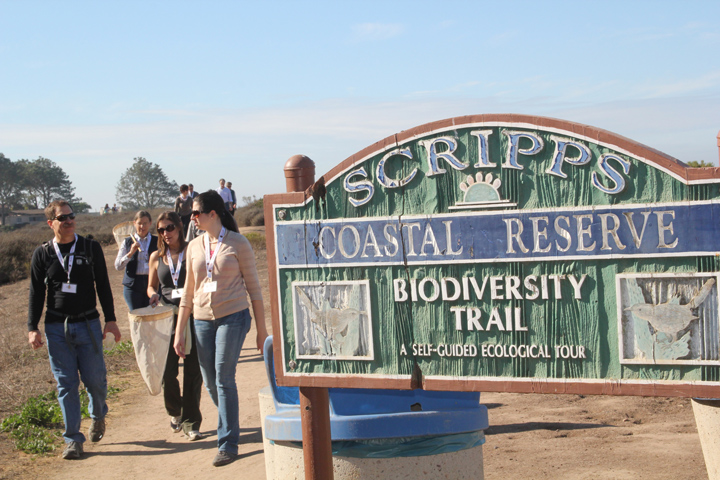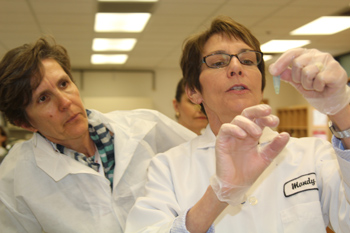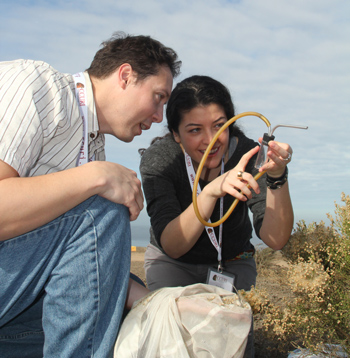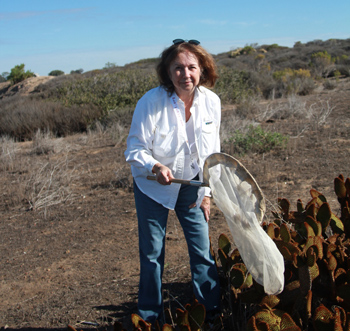‘Barcoding’ Life
Workshop brings 30 community college instructors to learn how to bridge the ‘biodiversity knowledge gap.'
January 30, 2014
By Kim McDonald

Workshop participants spent a Saturday morning collecting insects at the Scripps Coastal Reserve.
Kim McDonald, UC San Diego
San Diego is one of the world's "hotspots" for biodiversity, home to a diverse collection of creatures found nowhere else in the world. But like many ecological hotspots around the globe, most of the unique species in our region–particularly its insects, spiders and other small critters–have yet to be described and catalogued by scientists.
"Worldwide less than two million species have been named and we think there are at least five to 10 million species out there," said Heather Henter, a lecturer in UC San Diego's Division of Biological Sciences who teaches an undergraduate ecology laboratory course. "So how can we possibly conserve what we don't know is out there? This is the biodiversity knowledge gap. Imagine yourself as a manager of a museum and you only know about 30 percent of the paintings in your collection. How can you be an effective manager of your collection?"
On a clear January weekend, Henter and other faculty in the division brought 30 community college biology instructors from San Diego and other parts of the United States to the campus to show them how they might be able to help bridge this "biodiversity knowledge gap" while getting their students involved in research, which has been shown by educators to be particularly beneficial in helping students retain course material in the sciences.

Heather Henter (left) and Mandy Butler worked together on the idea for the innovative program.
Kim McDonald, UC San Diego
The idea is to get college students involved in sequencing the genes of insects and other creatures they collect in the field as part of their coursework, then to submit the data they produce to a worldwide database of genetic markers for species called the "Barcode of Life." It not only gets students more motivated and interested about science, but provides conservationists with critical information about the organisms they need to protect.
Among the visiting faculty were five Cuyamaca College biology instructors who intend to use what they learn at the workshop to get students at their college–which has a high proportion of Hispanic, Middle Eastern and other students from groups underrepresented in the sciences– involved in actual research by generating the sequence date for the genes of organisms they collect at their college’s 50-acre nature preserve. They also hope to incorporate it into the college’s free summer science camps for local high school students, which it started last year. “This is exactly what we were looking for,” said Kathryn Nette, chair of biology at Cuyamaca, who is working to develop the preserve into an educational tool for the community about biodiversity. "My hope is that this is going to be the start of a real collaboration with the faculty at UCSD."
The focus of the workshop was on introducing the community college faculty to a new technology called "DNA barcoding," which Henter explained, "has initiated a renaissance in taxonomy." Like the barcodes on supermarket packages that identify specific products to a supermarket scanner, short segments of genetic material in the genome have recently been discovered by biologists to be unique at or about the species level, which can provide approximate genetic markers, or "barcodes," for different species. These short segments of DNA–which can be easily identified, extracted and replicated by students in a classroom, then sent to a company to be sequenced–are also consistent among broad taxonomic groups.

Nick Reeves of Mt. San Jacinto College in Riverside County and Erin Ryan of Edmonds College in Seattle collect insects in the Scripps Coastal Reserve.
Kim McDonald, UC San Diego
The idea for using genetic barcodes as both a teaching and conservation tool at UC San Diego came about several years ago when Henter, who also oversees the undergraduate education programs at UC San Diego’s Natural Reserves System (part of the UC-wide Natural Reserve System), a collection of nature reserves around San Diego County used for biology research and teaching, got to talking about the biodiversity knowledge gap with Mandy Butler, a lecturer in the Division of Biological Sciences who teaches a course in which students learn to sequence genes and oversees the undergraduate biology laboratories. "Mandy knew I worked for the Natural Reserves System," recalled Henter, "so she said, ‘Is there something we could do out there that would be more interesting than the same canned laboratory sequencing exercise that thousands of students have done before?’ Our motivation was more the science at first. But then we quickly realized this this would be an important educational tool as well."
So the two biologists–along with biology professors Joshua Kohn and Kaustuv Roy, and Greg Rouse, a professor at Scripps Institution of Oceanography–applied for a two-year, $160,000 grant from the National Science Foundation. The grant, which the faculty members received in 2012, provided funds to develop a pilot program that allows 200 biology students each quarter–from both Henter's ecology lab class and Butler's gene sequencing class–to combine their efforts to characterize novel genotypes from insects, spiders and other invertebrate organisms in the Scripps Coastal Reserve. This 1,000-acre preserve consists of a small plot of land on the bluffs overlooking Black's Beach near the upper campus and the coast near Scripps Institution of Oceanography.

Kathryn Nette, biology chair at Cuyamaca College, hopes to start a similar program at her institution.
Kim McDonald, UC San Diego
Since 2012, one-third of the invertebrate species collected on the preserve by the students in Henter's ecology lab course and submitted to the Barcode of Life have been found to be new to the international database. Of the 49 spiders collected on just the tiny plot of land located on the bluffs off La Jolla Shores Drive, near the entrance to the winding road down to Black's Beach, and sequenced in the laboratory, 55 percent have barcodes unique to the database.
"I take students from the ecology lab out to the preserve on the second day of class who have never caught an insect before or even held an insect net before and within an hour they're collecting stuff that isn’t in the database," said Henter.
The community college faculty spent Saturday morning collecting spiders and other bugs from the shrubs and cacti in the preserve, then moved to the undergraduate sequencing lab in York Hall, where Butler showed them how to extract the genes from the organisms. Among the community college faculty were biology instructors from Palomar, Mesa, Mira Costa and Palomar Colleges in San Diego County and Mt. San Jacinto College in Riverside County, who discussed the prospects of collaborating with one another once they introduced the Barcode of Life into their own curricula.
"Because San Diego is such an important hotspot for biodiversity, I'm hoping this will lead to a bigger effort in the county for college instructors to have their students working together on projects of documenting biodiversity in this special place," said Henter.
The Agouron Institute provided funding last summer for three UC San Diego students–Yoshi Kono, Lauren Kitayama and Brock Wooldridge–to conduct research with Henter and the Barcode of Life project. Kitiyama, who processed DNA sequences of marine sandy shore invertebrates, said "the work showed me the infinite application of genetic barcoding, and how important it will be for species and habitat conservation in the future, as well as just how complicated and difficult true scientific endeavors can be."
